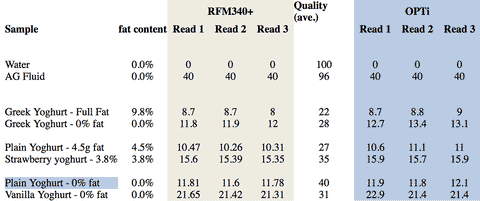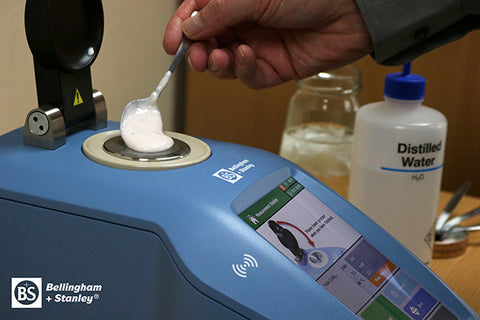When it comes to Artisan Food manufacturing many people turn to optical refractometers, such as this Brix Refractometer for Jam, as a quality control tool. Refractometers are simple instruments which use the speed of light passing through a sample to determine ‘refractive index’. The refractive index is related to the sample density, and hence its concentration (total dissolved solids). Optical handheld refractometers are simple to use. A small sample is applied to the prism and then a reading is taken by holding the instrument’s eyepiece up to your eye. Here you’ll be able to view a distinct split straight across the calibrated scale. We call this point the “borderline”.
Using an optical refractometer is great for homogenous samples such as soft drinks, fruit juices or even marmalades but when it comes to foodstuffs made up of emulsions containing fatty compounds, such as dairy products (including milk and yoghurt) that cause the light to scatter, the borderline cast onto the refractometer scale of an optical refractometer becomes blurred. This makes it difficult for the human eye to determine a finite reading.

Foodstuffs with fatty compounds cause light to scatter
Let’s Go Digital
This is where digital refractometers come in. Digital refractometers are ideal as they use an “internal reflection method” to illuminate the sample, and a sensitive detector (with some really clever mathematics) to easily and quickly establish the sharpest point of a blurred borderline to provide a stable reading.

Applying yoghurt to the RFM340-T
In an experiment to see how a digital handheld refractometer may be used as a quality control tool for a yoghurt manufacturer, Bellingham + Stanley, a Xylem brand, took a number of yoghurt samples varying by fat content and flavour, and applied them to a high accuracy RFM340-T digital refractometer. This instrument, typically found in a laboratory or factory, was used to establish both the average reading and quality number; the latter being a comparison of the borderline sharpness to that of water at 100. The samples were also applied to an OPTi digital handheld refractometer to establish readability and average concentration in the Brix scale.
It can be seen that the yoghurt samples gave relatively low quality numbers on the RFM340-T, confirming their poor borderline characteristics that would be indeterminable using an optical refractometer. The Brix values (total dissolved solids) from the RFM340-T showed a spread of 0.1 to 0.2 Brix between applications, confirming reliable measurement.

Taking a reading with an OPTi
Likewise, the readings on the OPTi refractometer were also stable to within 0.2 between applications and were comparable to the readings established on the laboratory instrument.
The experiment confirmed the suitability of an OPTi digital handled refractometer as a tool for quality control checking of yoghurt and other non-homogenous food samples where optical refractometers are not so easily used; offering artisan food producers a quick and easy method of controlling non-homogenous product during manufacture and beyond.
Consistent Results Require Temperature Control
Temperature control when measuring with a refractometer is key to achieving accurate and consistent results. Here at Refractometer Shop this is something we are keenly aware of and that is why we have teamed up with thermometer and data logger specialists, ebro – a Xylem brand, in order to bring you the perfect line-up of complementary products to our handheld refractometer range.
Click here to read our blog on thermometers and data loggers.
